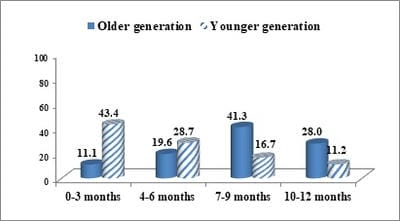Intergenerational patterns of contraception use during extended postpartum period among women in Haryana, India
Gupta P.1*
DOI: https://doi.org/10.17511/ijphr.2017.i5.04
1* Pallavi Gupta, Research Scholar, International Institute for Population Sciences (IIPS), Mumbai, Maharashtra, India.
Background and Objectives: Present study is an attempt to examine the generational patterns of adoption of family planning during extended postpartum period before and after adjusting for individual, household and contextual factors. The study was further extended by analysing timing and type of contraceptive methods used by generations. Methods: Primary survey data from Rohtak district of Haryana, India, was used, in which two successive generations were interviewed regarding family planning and contraception use. Results: Findings demonstrated the different patterns of family planning use across the generations after adjusting for other potential covariates. The early initiation of use of family planning and use of modern methods during postpartum period was higher among younger women. Conclusions: Though, by time and generations there has been a significant change in the extent and patterns of contraceptive adoption among postpartum women, still in few segments, younger generation women reported low use of family planning which calls for urgent policy attention.
Keywords: Intergenerational, Contraception, Postpartum period, Family Planning Methods
| Corresponding Author | How to Cite this Article | To Browse |
|---|---|---|
| , Research Scholar, International Institute for Population Sciences (IIPS), Mumbai, Maharashtra, India. Email: |
Gupta P, Intergenerational patterns of contraception use during extended postpartum period among women in Haryana, India. Public Health Rev Int J Public Health Res. 2017;4(5):125-133. Available From https://publichealth.medresearch.in/index.php/ijphr/article/view/72 |


 ©
© 
